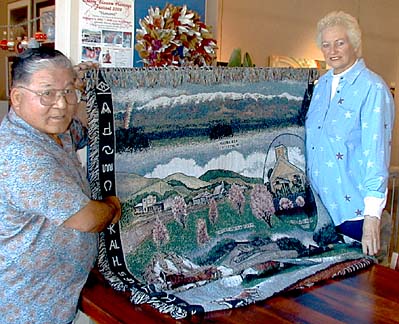


|
WAIMEA, Hawaii >> In late January 1992, Jimmy Tohara of North Kohala on the Big Island had just walked out of a visit to his dentist in Waimea. Rather than numbing him, the dental appointment seems to have sharpened his senses. Festival to blossom
on Big IsleA favorite tradition will bloom
for the 10th year Saturday
By Rod Thompson
rthompson@starbulletin.com
"It was a nice, clear, brisk day. As I looked up toward Mauna Kea, it was beautiful, capped with snow. There was not a single cloud in the sky," he said.
Here are the events planned from 9 a.m. to 3 p.m. Saturday: Festival facts
>> Kahilu Theatre: Taiko drums, bon dancing, karaoke, hula, etc.
>> Tents around Kahilu Theatre: arts, crafts, foods and games.
>> Firehouse Gallery: calligraphy, cherry blossom art.
>> Parker Ranch Historic Homes: tea ceremony, paper making (no entry fee).
>> Fireside Food Court: mochi pounding.
>> Church Row Park: bonsai exhibit and kite flying.
>> Kamuela Hongwanji Temple: open house, bento lunches.
>> Cook's Discoveries: rice cooking, origami, crochet lei demonstrations.
>> Kamuela Liquor Store: sake tasting.
>> Town Hall: Outdoor Circle plant sale.
Passing Church Row Park, he noted, "The cherry blossoms were in full bloom."
The sight of the deep pink blossoms triggered something in him. He began talking to one person after another about starting a cherry blossom festival.
He was pretty much ignored until he telephoned George Yoshida, director at the time of the Hawaii County Department of Parks and Recreation.
"I had never met the man," Yoshida recalled last week. But after some inquiries by his staff, Yoshida adopted the cherry blossom idea. "We took the ball and we started running. We couldn't do it ourselves. It was the community pulling together," he said.
This Saturday, the 10th annual Cherry Blossom Heritage Festival will be held not only in Church Row Park but in several other Waimea locations such as the Parker Ranch Historic Homes, indicating how the event has grown.
Tohara, 78, will be honored for conceiving and pursuing the idea. Also honored will by Dolly Loo, 77, one of the community people who "pulled together," producing the festival brochure for the past 10 years.
The word "heritage" in the festival name refers to events decades earlier.
In 1953, newspaperman Fred Makino died after 41 years of publishing the Japanese language Hawaii Hochi. His widow arranged for three Formosan cherry trees, which produce flowers but no fruit, to be brought to Waimea in his honor.
Eventually Parker Ranch gardener Isami Ishihara propagated many more trees, and in 1972, the Waimea Lions Club planted 20 in Church Row Park.
"Then the battle began," says Loo's brochure. "Careless maintenance people ran trees over with mowers and scraped the bark with Weed Eaters. Then would-be rodeo stars practiced barrel racing around the trees." The Lions put up wire cages to protect the trees and thieves stole the wire.
But the trees survived, and when Emperor Hirohito visited the Mauna Kea Beach Hotel in 1975, the Lions planted 50 more trees to honor him and the Japanese immigrants who settled in Waimea 100 years earlier.
Tohara retired from the Mauna Kea Beach Hotel in 1991 after 35 years there and elsewhere as a plumber.
Waimea was growing and a proposed bypass around the town, never built, threatened to bypass local culture too. Japanese-American cowboys had been the backbone of Parker Ranch. The cherry blossoms were another sign of Japanese culture that Tohara wanted to preserve.
In Japan, people hold "hanami" events, "flower viewing," Tohara said. People there spread mats under the trees and then eat, drink, and sing, he said.
This year's Waimea festival, from 9 a.m. to 3 p.m. will also have food, drink, and song. There will be demonstration of Japanese fabric assemblage, paper making, and kite-flying.
And there will be cherry blossoms, something that is never a certainty. The trees need cold weather before they will blossom. "My husband said they have to have snow on Mauna Kea to stress them," Loo said.